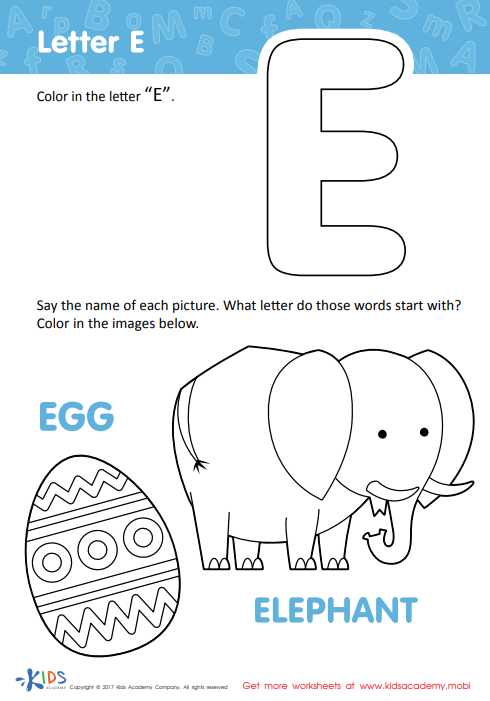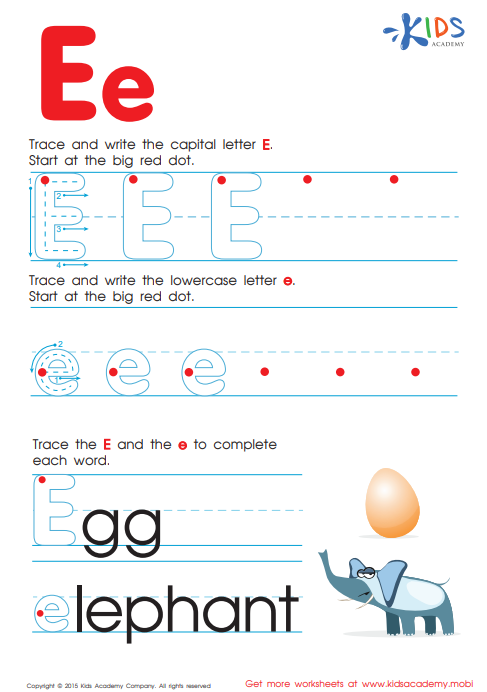-
English
-
English Pre-K
-
Unit 1: Early Literacy Skills
-
ABCs
- Pre-writing Activities
- Letter A
- Letter B
- Letter C
- Letter D
- Letter E
- Letter F
- Letter G
- Letter H
- Letter I
- Letter J
- Letter K
- Letter L
- Letter M
- Letter N
- Letter O
- Letter P
- Letter Q
- Letter R
- Letter S
- Letter T
- Letter U
- Letter V
- Letter W
- Letter X
- Letter Y
- Letter Z
-
Phonological Awareness
- Rhyming Words
- Letter Sounds B, C, D, and F
- Letter Sounds G, H, J, and K
- Letter Sounds L, M, N, and P
- Letter Sounds Q, R, S, and T
- Letter Sounds V, W, X, Y, and Z
- Letter Sounds A, E, and I
- Letter Sounds O and U
- Beginning Sounds
- Matching Letters to Sounds
-
ABCs
-
Unit 2: Vocabulary
-
Common Words
- Sorting Words into Categories
- Color Words
- Verbs and Adjectives
-
Sight Words
- Sight Words 'I' and 'Can'
- Sight Words 'You' and 'Like'
-
Common Words
-
Unit 3: Print Awareness
-
Parts of a Book
- Working with a Book
- Spaces Between Words
- Text and Illustrations
-
Picture Books and Poems
- Picture Book Text Features
- Poem Text Features
- Signs and Labels in the Community
-
Parts of a Book
-
Unit 4: Reading Literature
- Questions About Stories
- Discussing Stories
-
Unit 5: Reading Informational Texts
- Retelling Details in a Text
- Questions About a Text
- Connections Between Events
- Text Features
- Describing Illustrations
-
Unit 1: Early Literacy Skills
-
English Pre-K
-
Math
-
Math for Pre-Kindergarten
-
Logic and Geometry
-
Matching and Sorting
- Same and Different
- Which One Is a Little Different?
- Objects That Go Together
- Sorting by Color and Size
- Sorting The Same Group in Different Ways
- Patterns
-
Shapes
- Shapes in Our Environment
- Naming Shapes Regardless of Size
- Making Shapes in Preschool
- Comparing Shapes
- Relative Positions
- Sorting Shapes
-
Matching and Sorting
-
Early Number Sense
-
Numbers 1–5
- Counting to 3
- Counting to 5
- Arranging Objects up to 3 Objects
- Arranging up to 5 Objects
- Writing Numbers 1–5
-
Numbers 1–5
-
Numbers up to 10
- Counting to 10
- Arranging up to 10 Objects
- Number 0
- Writing Numbers 6–10
- Breaking Down Numbers 6-10
-
Logic and Geometry
-
Math for Pre-Kindergarten
Letter E
Today, we’re going to be looking at the letter E. In this article, we’ll provide you with ideas to help you teach your child this letter. One of the key points in helping your child learn new material is through exposure. For example, while teaching the letter E, it is very helpful to keep around objects that start with this letter like eating eggs for breakfast, using an eraser, watching videos about elephants, etc. In addition, it’s a good idea to pace the learning process for your child, as in teaching them only one or two letters a week, or adopting the “Letter of the Week'' strategy. Nevertheless, incorporating previously taught letters is also important in order to maintain and strengthen retention.
Activities
Learning doesn’t always come easy to children, they would much rather be playing and running around than sitting down in a chair and repeating after us. Thus, trying to make the process fun can come in handy. One way to lighten up learning material is through activities.
Before you start with the activities, you can prepare your child by watching this Letter E video from Kids Academy.
- Letter E Coloring Sheet: One of the easiest activities you can prepare for your child is worksheets, all you have to do is print them out and you’re good to go! This coloring worksheet from the Kids Academy website is a great option for getting your child acquainted with the uppercase shape of the letter E. It also emphasizes the sound the letter makes through providing images of words that start with the letter E: an elephant and an egg.

- Letter E Tracing Page: Another Kids Academy worksheet is this tracing worksheet that helps your child embark on their writing journey through tracing the uppercase and lowercase forms of the letter E. Tracing not only helps acquaint your child with the shape of the letter, but also works on their motor skills such as their palmar grasp. Similarly to the previous worksheet, this one also provides images of words that start with the letter E to help kids learn the sound the letter makes.

- Pom-Pom E: For this activity, you’ll need some multicolored pom-poms and glue, and a drawing or print out of a big bubble letter E, you can also use it for both uppercase and lowercase forms. All your Child has to do is glue pom-poms inside the letter. This activity mainly works on exposure. Instead of instructing your child to learn the letter, you’re providing them with a fun activity that passively offers them the shape of the letter E. You can try to emphasize the name of the letter through repeating: “Let’s glue more pom-poms on the letter E”.
- Elephant Letter Cutout: In this activity, your child will be making the shape of an elephant from the letter E. Associating a letter to a word helps children retain the shape and sound of the letter better. First, cut out a cardboard letter E, then also cut out the shapes of an elephant trunk, ears and eyes (Or you can use googly eyes, kids love them!). Then, have your child glue or pin the elephant cutouts onto the letter E to make it look like an elephant.
With these activities, you will hopefully be able to easily teach your child the letter E this week.

